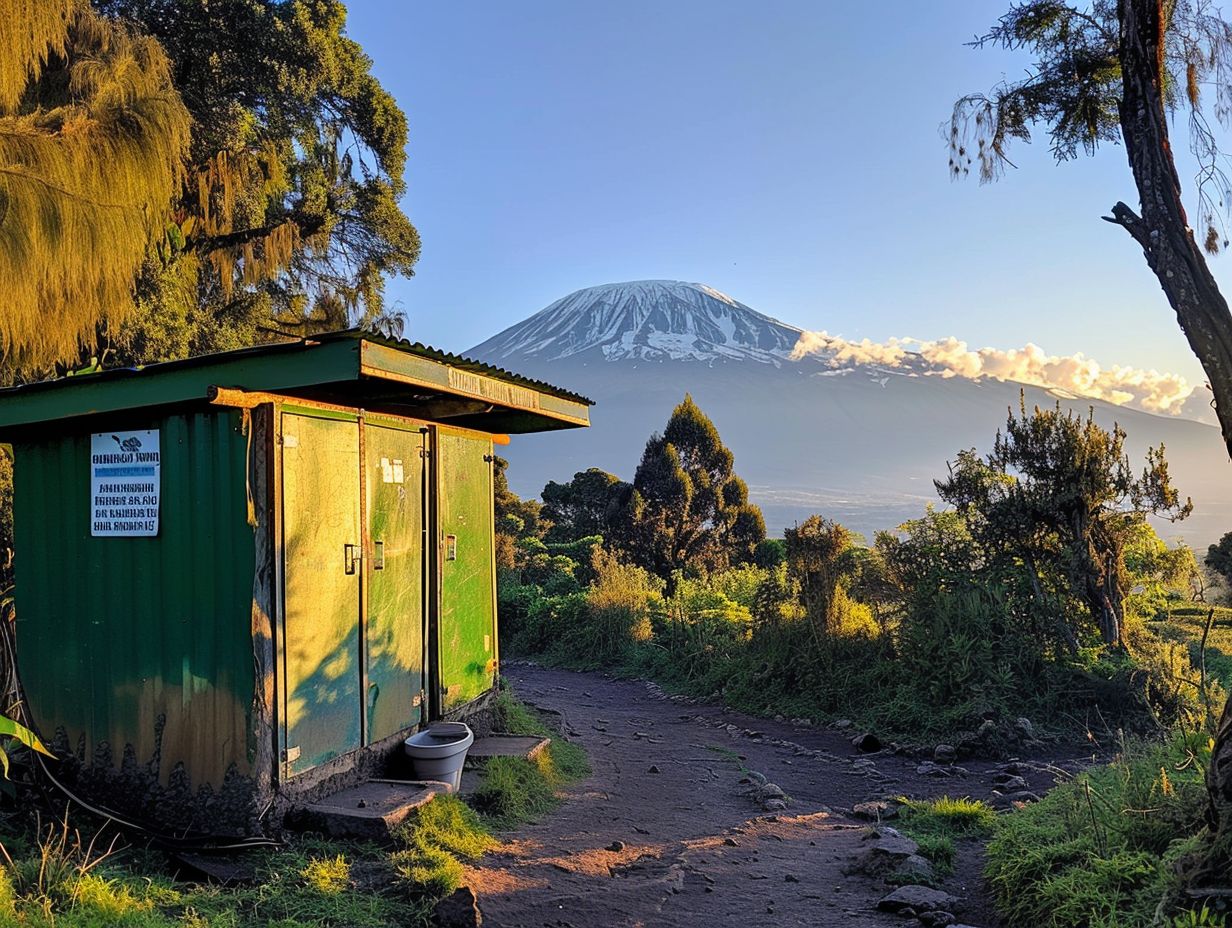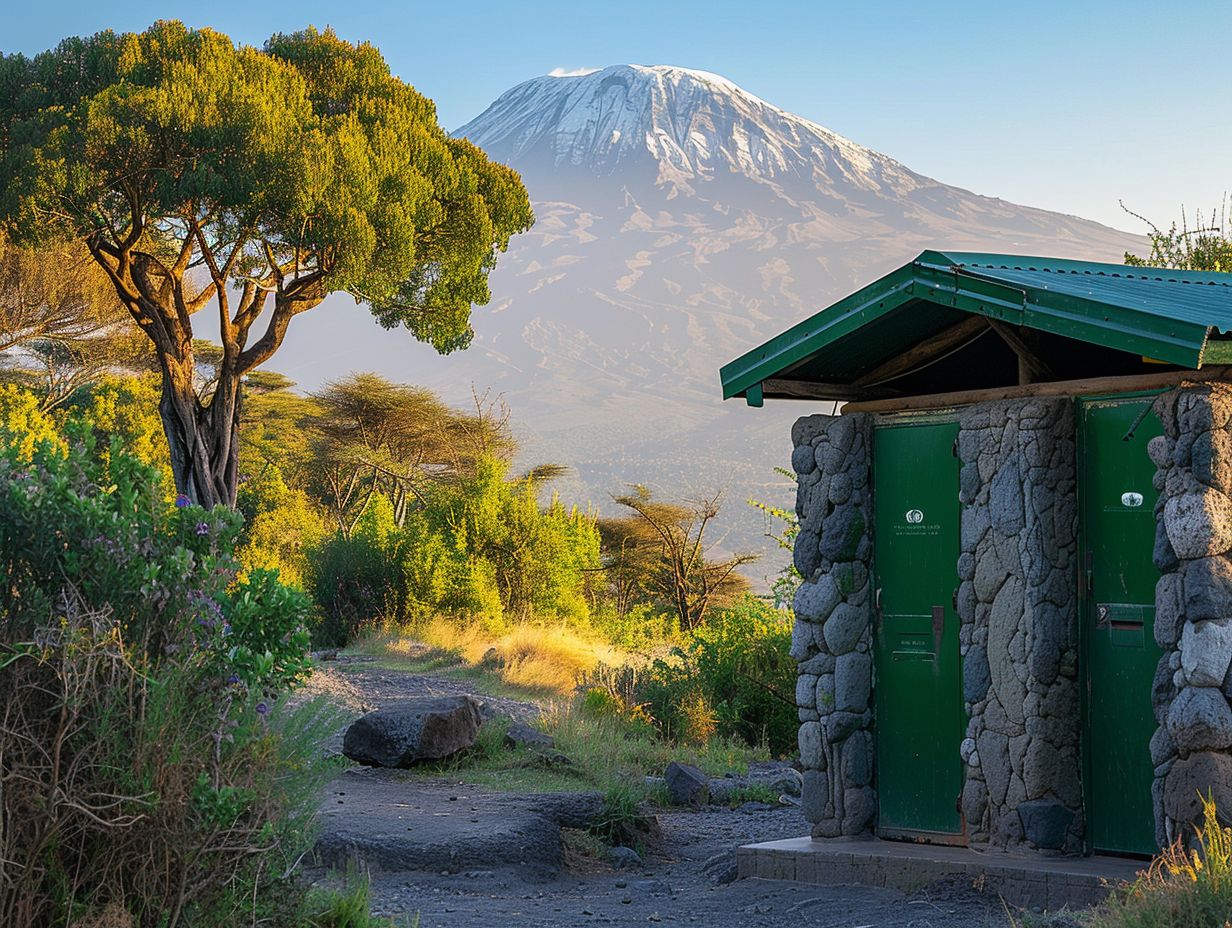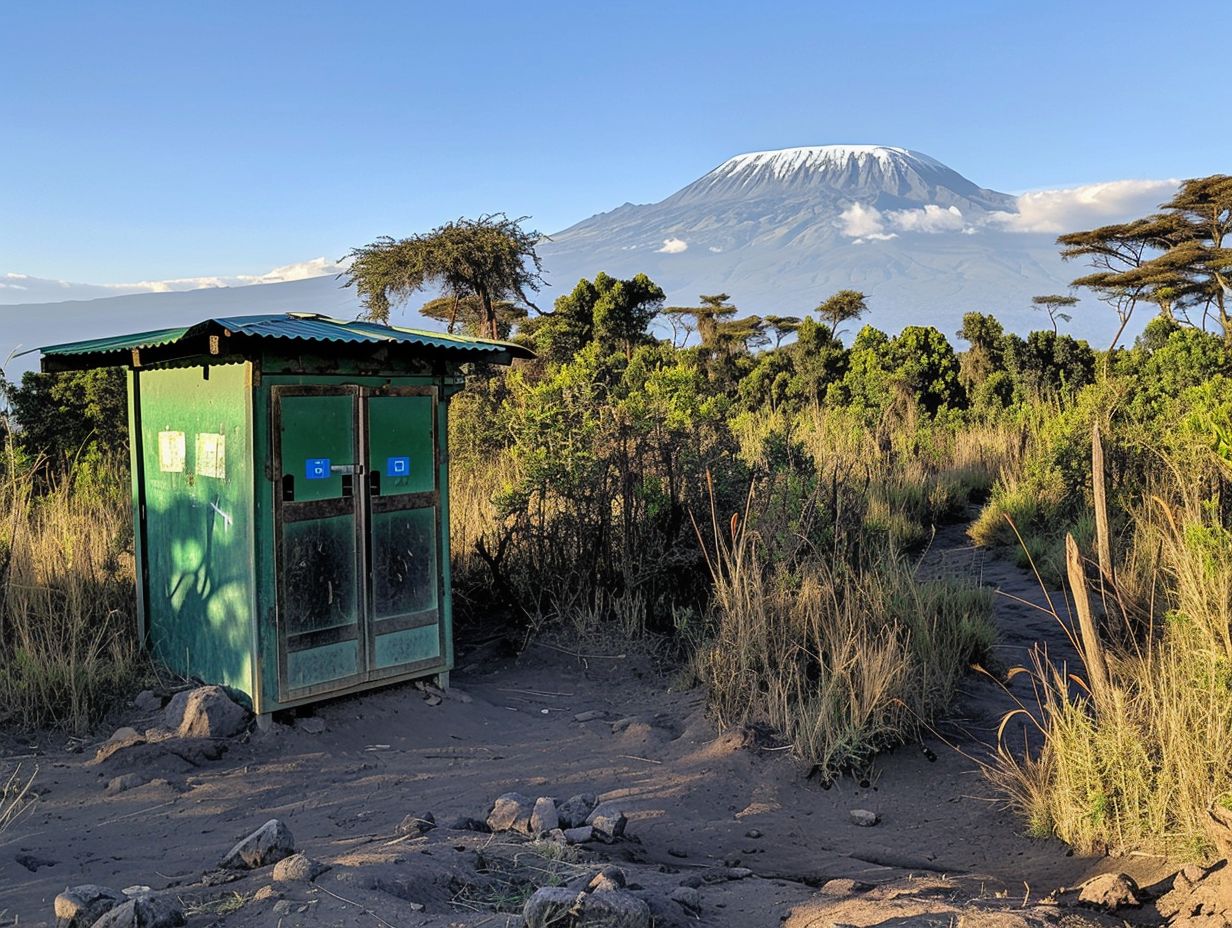
Proper sanitation is crucial, especially on a natural wonder like Kilimanjaro.
We explore the history and evolution of toilets on Kilimanjaro, as well as the current state and challenges of maintaining them.
We delve into the impact of improper toilet usage on the environment and health risks.
Looking ahead, we discuss proposed solutions for improving toilets on Kilimanjaro and how tourists can play a role.
We provide tips for using toilets responsibly while exploring this majestic mountain.
Join us as we uncover the importance of proper sanitation on Kilimanjaro.
Key Takeaways:

- Proper sanitation is crucial on Kilimanjaro to protect the environment and the health of climbers.
- The evolution of toilets on Kilimanjaro reflects the changing attitudes towards environmental conservation and sustainable tourism.
- Toilets on Kilimanjaro face challenges in maintenance and tourists can help by being mindful of their impact and following proper usage guidelines.
The Importance of Proper Sanitation on Kilimanjaro
Proper sanitation on Kilimanjaro is crucial for maintaining the pristine environment and ensuring the health and well-being of trekkers and the local ecosystem.
Without appropriate sanitation practices, the delicate ecosystem of Kilimanjaro could face contamination from human waste, leading to serious health risks for both visitors and local wildlife. The introduction of portable toilets and wet wipes can significantly reduce the environmental impact of waste disposal. Promoting responsible waste management among trekkers is essential to preserve the natural beauty of the mountain and protect its diverse flora and fauna.
The History of Toilets on Kilimanjaro
The evolution of toilet facilities on Kilimanjaro has been influenced by the increasing number of trekkers and the need for sustainable waste management solutions amidst the unique environmental challenges of the region.
Over the years, the mountain has seen a transition from basic long-drop toilets scattered along the trails to more modern portable options that are easier to maintain and eco-friendly. These advancements have been driven by a growing awareness of the impact of human waste on the delicate ecosystem of Kilimanjaro.
Environmental concerns play a crucial role in shaping toilet strategies, with a focus on minimizing pollution and preserving the pristine surroundings.
How Have Toilets Evolved on Kilimanjaro?
Toilets on Kilimanjaro have evolved from basic long-drop facilities to more advanced portable options, catering to the increasing demand for hygienic and environmentally friendly solutions.
Mount Kilimanjaro, with its growing popularity as a trekking destination, saw the need for more sophisticated toilet facilities to enhance the mountain experience for climbers. In response, private toilet tents started to be provided at high-altitude camps, offering a more comfortable and exclusive option for trekkers.
Integration of eco-friendly practices became a priority, with waste being properly managed and disposed of in environmentally conscious ways. Biodegradable materials and low-impact sanitation systems were introduced, reducing the ecological footprint on the mountain.
The Current State of Toilets on Kilimanjaro
The current state of toilets on Kilimanjaro reflects a mix of public and private facilities at various campsites, emphasizing the importance of proper waste disposal and maintaining a hygienic environment for trekkers.
Public toilet facilities are strategically placed along popular routes, offering trekkers a convenient option for rest stops. Guides play a vital role in educating climbers about responsible waste management practices, ensuring that the mountain’s ecosystem remains unharmed.
The presence of private toilet facilities at some campsites provides a more exclusive and comfortable experience for those seeking added privacy. As climbers ascend the mountain, access to clean and well-maintained restroom facilities becomes crucial for their overall comfort and well-being during the challenging journey.
What Types of Toilets are Currently Used on Kilimanjaro?

The toilet options on Kilimanjaro range from basic long-drop toilets to portable camping toilets, with some campsites featuring private facilities and environmentally friendly solutions like chemical camping toilets.
Public toilets are available at common rest stops along the trekking routes, providing convenient facilities for trekkers. These facilities are often maintained by dedicated staff members who ensure cleanliness and functionality. Private toilets can be found at selected accommodations for those seeking more comfort and privacy during their climb.
Portable camping toilets are popular among trekkers who prefer the convenience of having a personal restroom option at their disposal. These toilets are compact and easy to set up, making them ideal for trekkers who value hygiene and convenience on the mountain.
Specialized facilities designed for trekkers offer advanced features such as biodegradable waste disposal systems and eco-friendly designs. Staff members play a crucial role in managing these facilities, ensuring that they are well-stocked, clean, and properly maintained to provide visitors with a comfortable and hygienic trekking experience.
What Are the Challenges of Maintaining Toilets on Kilimanjaro?
Maintaining toilets on Kilimanjaro poses challenges related to waste disposal, litter management, and ensuring environmentally friendly practices while dealing with issues such as odors and ventilation in mountainous terrain.
Given the high altitude and remote nature of the mountain, transporting and managing waste becomes a significant obstacle. One strategy employed is the use of biodegradable materials to minimize the impact on the environment.
Regular cleaning schedules and trained staff play a crucial role in maintaining hygiene standards. Effective ventilation systems are essential to mitigate odors and provide a comfortable experience for climbers. Sanitation services are vital to prevent the spread of diseases in such isolated locations.
The Impact of Improper Toilet Usage on Kilimanjaro
Improper toilet usage on Kilimanjaro can have detrimental effects on the natural environment, leading to health risks for trekkers and compromising the sanitation services available at campsites and restroom facilities.
When proper waste disposal practices are not followed in such delicate ecosystems, the human waste can contaminate water sources, affecting both wildlife and human health. The presence of fecal matter can introduce harmful pathogens into the ecosystem, leading to waterborne illnesses. The strain on existing sanitation services due to improper toilet practices can result in overflowing facilities, exacerbating the environmental impact.
How Does Improper Toilet Usage Affect the Environment on Kilimanjaro?
Improper toilet usage on Kilimanjaro contributes to environmental pollution through waste contamination, litter accumulation, and disturbs the natural balance of the ecosystem, impacting both visitors’ peace of mind and the mountain’s ecological integrity.
Human waste left improperly on the mountain can seep into the soil and water sources, posing a threat to local flora and fauna. Litter from toilet paper and non-biodegradable materials further degrades the pristine environment, disrupting the fragile ecosystem’s equilibrium.
Pack-in, pack-out practices are essential to minimize the ecological impact. Visitors are encouraged to carry out all waste, including hygienic wet wipes, to ensure no trace is left on the mountain. By adopting responsible waste management habits, hikers can preserve the natural beauty of Kilimanjaro for future generations to enjoy.
What Are the Health Risks of Improper Toilet Usage on Kilimanjaro?
Improper toilet usage on Kilimanjaro heightens health risks for trekkers due to exposure to contaminated waste, lack of proper sanitation services, and the absence of secluded spots for hygienic practices, emphasizing the need for improved toilet management strategies.
Exposure to contaminated waste on the mountain poses significant threats to the well-being of climbers, leading to potential gastrointestinal illnesses and other infections. The lack of adequate sanitation services further exacerbates these risks, as trekkers must often resort to makeshift arrangements that do not comply with proper hygiene standards.
Providing secluded spots for hygienic practices is essential for maintaining the health and well-being of climbers. These areas not only offer privacy but also help prevent the spread of disease-causing bacteria in the environment.
Hygienic wet wipes play a crucial role in reducing health risks by allowing trekkers to maintain cleanliness and hygiene even in challenging conditions. They provide a convenient way to sanitize hands and surfaces, minimizing the risk of contamination and infection.
The Future of Toilets on Kilimanjaro

The future of toilets on Kilimanjaro hinges on implementing sustainable solutions that prioritize environmental protection, hygiene standards, and efficient waste management practices to enhance the overall trekking experience for visitors.
One key advancement being explored is the utilization of eco-friendly materials in the construction of restroom facilities to minimize the carbon footprint. Integrating water-saving mechanisms like dual-flush toilets and low-flow faucets can help in conserving water resources on the mountain.
Implementing proper waste segregation systems, including composting toilets for organic waste and recycling bins for non-biodegradable items, can significantly reduce the environmental impact of waste disposal.
What Are the Proposed Solutions for Improving Toilets on Kilimanjaro?
Proposed solutions for enhancing toilets on Kilimanjaro revolve around introducing eco-friendly facilities, educating trekkers on responsible waste disposal, and ensuring access to proper sanitation services and hygienic amenities to preserve the mountain’s natural beauty.
One innovative idea involves incorporating water-saving toilets that utilize greywater recycling systems, reducing water wastage and environmental impact. Implementing composting toilets can help in managing organic waste sustainably, minimizing pollution and promoting the ecosystem’s health.
To complement infrastructure improvements, educational initiatives can be introduced to inform trekkers about the significance of maintaining cleanliness in such delicate ecological zones. Incorporating informative signage along trekking routes can raise awareness about the importance of responsible waste management.
How Can Tourists Help with Maintaining Proper Toilets on Kilimanjaro?
Tourists can contribute to maintaining proper toilets on Kilimanjaro by following responsible waste disposal practices, minimizing litter, adopting environmentally friendly behaviors, and supporting efforts to improve restroom facilities for a sustainable trekking environment.
To play a role in preserving toilet facilities on Kilimanjaro, visitors should embrace a ‘leave no trace’ mindset, ensuring they carry out all waste, including biodegradable items. They can opt for reusable containers to minimize packaging waste and practice responsible recycling where possible.
Engaging in these actions not only enhances the trekking experience but also supports the efforts to keep the natural beauty of Kilimanjaro intact. Tourists can organize or participate in cleanup initiatives to address any existing litter concerns around restroom areas.
Tips for Using Toilets on Kilimanjaro
For trekkers on Kilimanjaro, utilizing toilets effectively involves carrying essential supplies like portable toilets, plastic bags for waste disposal, and hygienic wet wipes to ensure comfort, privacy, and environmental consciousness throughout the journey.
When nature calls amidst the rugged terrain of Kilimanjaro, trekkers should always prioritize privacy and respect for the environment. Opting for portable toilet solutions not only guarantees convenience but also minimizes the ecological impact. Packing waste in sealed bags ensures that no trace is left behind.
Creating a dedicated waste disposal system for your trekking group can help in efficiently managing human waste while treading lightly on the mountainside. Remember, maintaining proper hygiene practices goes a long way in preventing contamination and preserving the natural beauty of the surrounding landscape.
What Should Tourists Bring for Proper Toilet Usage on Kilimanjaro?
Tourists embarking on a Kilimanjaro trek should pack essential items like portable toilets, waste disposal bags, hygienic supplies, and consider the environmental impact of their toileting practices by using secluded spots away from trails and campsites.
When preparing for a trek on Kilimanjaro, it is crucial to have the right tools for proper waste management. Apart from portable toilets, waste disposal bags play a significant role in packing out all human waste. Carrying biodegradable wipes, hand sanitizers, and biodegradable toilet paper ensures maintaining cleanliness amidst challenging terrain.
Choosing an appropriate secluded spot away from water sources and marked trails is paramount for preserving the natural surroundings. Ensuring that waste is properly packed out and disposed of in designated areas helps in upholding environmental standards and promotes responsible trekking practices.
How Can Tourists Minimize Their Impact on the Environment When Using Toilets on Kilimanjaro?

To reduce environmental impact while using toilets on Kilimanjaro, tourists should practice ‘pack in, pack out’ waste management, ensure proper waste disposal using gravity-based systems, manage odors effectively, and prioritize the use of hygienic wet wipes for sustainable toileting solutions.
One effective strategy for waste management in high-altitude areas like Kilimanjaro is to adopt the ‘pack in, pack out’ approach, where individuals are responsible for carrying out all waste they generate during their trek. This not only minimizes the impact on the delicate ecosystem but also ensures a cleaner environment for future visitors.
Utilizing gravity-based disposal systems can be a practical solution to ensure proper waste disposal on the mountain. These systems rely on the force of gravity to transport waste to designated collection sites, reducing the need for complex infrastructure and minimizing the risk of contamination.
Managing odors is another crucial aspect of maintaining hygiene and minimizing environmental impact. Implementing odor-control measures such as using biodegradable odor-neutralizing agents or choosing well-ventilated restroom facilities can help in creating a more pleasant environment for all trekkers.
Regarding promoting sustainability and cleanliness, the use of hygienic wet wipes plays a significant role. Unlike traditional toilet paper, wet wipes are more effective at cleaning, leave no residue, and are eco-friendly, making them an ideal choice for toileting in sensitive environments like Kilimanjaro.
Frequently Asked Questions
1. What are Kilimanjaro Toilets?
Kilimanjaro Toilets are a type of portable toilet specifically designed for use in outdoor and remote locations, such as campsites, construction sites, and hiking trails. They are named after Mount Kilimanjaro, the highest mountain in Africa, and are designed to be durable, hygienic, and environmentally friendly.
2. How do Kilimanjaro Toilets work?
Kilimanjaro Toilets use a simple but effective system to dispose of waste. The toilet has a tank for waste, which is then mixed with a neutralizing agent to eliminate odors and break down the waste. The liquid waste is then drained into a separate tank, while the solid waste is collected and disposed of properly later.
3. Are Kilimanjaro Toilets environmentally friendly?
Yes, Kilimanjaro Toilets are designed with the environment in mind. They use biodegradable and non-toxic chemicals to neutralize waste and are designed to minimize water usage. They also have a low carbon footprint, making them a more eco-friendly option compared to traditional toilets.
4. How are Kilimanjaro Toilets different from other portable toilets?
Kilimanjaro Toilets are specifically designed for use in outdoor and remote locations, making them more durable and better equipped to handle rough terrain. They also have a larger waste tank, allowing them to be used by more people before needing to be emptied. Additionally, Kilimanjaro Toilets are designed to be more comfortable and hygienic, with features such as hand sanitizers and toilet paper dispensers.
5. Where can Kilimanjaro Toilets be used?
Kilimanjaro Toilets can be used in various outdoor and remote locations, such as campsites, construction sites, music festivals, and hiking trails. They are also suitable for use in emergency situations, such as natural disasters or refugee camps. However, they should not be used in areas with extreme temperatures, as this can affect the efficiency of the waste disposal system.
6. Can I rent Kilimanjaro Toilets for my outdoor event?
Yes, many companies offer rental services for Kilimanjaro Toilets. They will deliver, set up, and maintain the toilets throughout the duration of your event. This is a convenient and cost-effective option for outdoor events, as it eliminates the need for traditional toilets or constantly cleaning and emptying portable toilets.